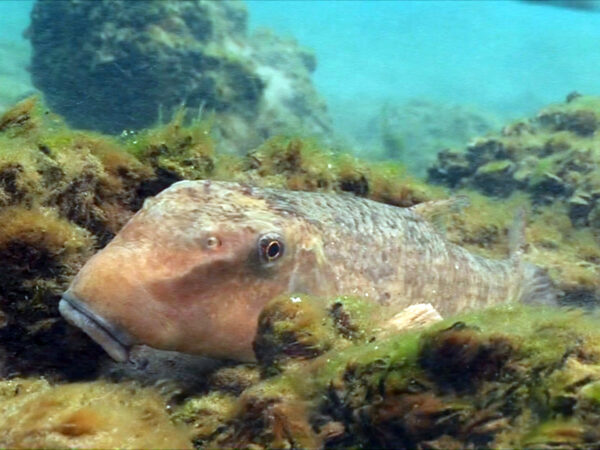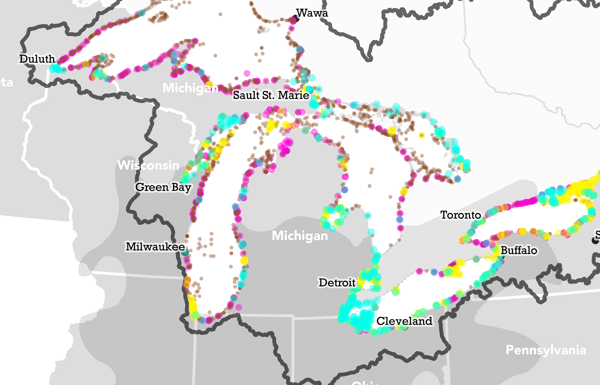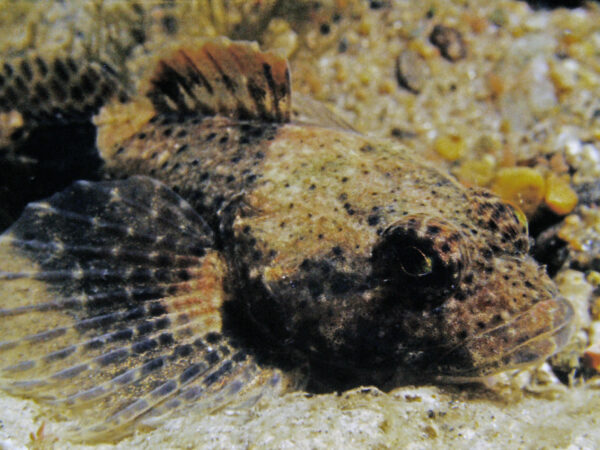
The nonprofit organization called Sturgeon for Tomorrow and a team of U.S. and Canadian fishery biologists have been working together for seven years on the Sturgeon-in-the-Classroom program to engage students through community or citizen science and help reintroduce lake sturgeon in Great Lakes tributaries where they once thrived.
Brief history of lake sturgeon
In the late 1600s and early 1700s, French explorers and voyageurs noted that the waters from Lake Huron to Lake Erie teemed with lake sturgeon. During the 1800s, lake sturgeon were found in all the Great Lakes but were one of the most abundant fish species in the Lake Huron to Lake Erie corridor.
It was in the 1800s that the relationship between lake sturgeon and humans was described as “kaleidoscopic.” Before the 1860s, commercial fishermen slaughtered lake sturgeon as a nuisance fish because they became entangled in nets, destroying them, and because they sucked up the spawn. During this same time period, lake sturgeon were stacked like firewood and left to dry on the banks of the Detroit River in Amherstburg, Ontario. The mummified bodies of the oily fish were burned to heat the boilers of wood-burning steamboats. Then during the mid-1860s, the economic value of lake sturgeon was discovered when their eggs became sought after as caviar and their smoked flesh became craved as a delicacy. This led to the development of an important commercial fishery.
During the late-1800s, the corridor between Lakes Huron and Erie was recognized as one of the best lake sturgeon fisheries in North America. For example, in 1880, lakes Huron and St. Clair produced over 4 million pounds of lake sturgeon. Detroiters had the satisfaction of knowing that they got the best sturgeon steaks and the best caviar in the world caught in local waters. A “caviar factory” was even located in Algonac, Michigan on the St. Clair River in 1890.
By the early-1900s the lake sturgeon fishery was in decline primarily due to overfishing. Sturgeon populations continued to decline and were nearly extirpated – locally extinct – by the middle of the 20th century. Overfishing, dam construction, and water pollution had driven these lake sturgeon populations toward the brink of extinction.
Today, the lake sturgeon population in Michigan has been estimated to be about 1% of its former abundance. The sturgeon population in the waters from southern Lake Huron to western Lake Erie is at 10% of its historical abundance. As a result of these population declines, the lake sturgeon is designated a “species of special concern” by the U.S. Fish and Wildlife Service, a threatened species in North America by the American Fisheries Society, a globally rare species by The Nature Conservancy, and a threatened species in the State of Michigan and Province of Ontario.
Sturgeon-in-the-Classroom program
The Huron-Erie corridor has the largest free-ranging population of lake sturgeon in the Great Lakes – approximately 40,000 individuals. Sturgeon for Tomorrow, U.S. Fish and Wildlife Service, Michigan Department of Natural Resources, Ontario Ministry of Natural Resources and Forestry, and the University of Windsor have come up with an elegant idea to restock tributaries where sturgeon once thrived with young lake sturgeon that have been reared from fertilized eggs from St. Clair River sturgeon and to simultaneously instill conservation stewardship in our youth.
In 2015, St. Clair-Detroit River Sturgeon for Tomorrow and Black Lake Chapter of Sturgeon for Tomorrow signed a Memorandum of Understanding with the Michigan Department of Natural Resources to coordinate the Sturgeon-in-the-Classroom program. “Historically, the threats to sturgeon were overfishing, dams, and water pollution, but today the major threat is indifference or apathy,” said Jim Felgenauer of St. Clair-Detroit River Sturgeon for Tomorrow. “Sturgeon-in-the-Classroom provides real-world experiences with helping save a threatened species and not just a virtual experience. For me, the real heroes in the program are the teachers that go the extra mile in providing these experiences to their students.”
Fishery biologists collect mature male and female lake sturgeon from the St. Clair River in the spring as part of the Port Huron Gamete Program. Gametes are unfertilized reproductive cells, called sperm in males and eggs in females, that come together during spawning to form fertilized eggs.

Fishery biologists from the U.S. Fish and Wildlife Service’s Alpena Fish and Wildlife Conservation Office collect eggs from a female lake sturgeon. (Photo Credit: U.S. Fish and Wildlife Service)
Eggs are removed from the female sturgeon and milt or sperm are removed from the males. The eggs are stirred in a mixture of iodine and clay to both disinfect the eggs and prevent them from sticking together using a feather. The milt or sperm is then added to produce fertilized sturgeon eggs.
Fertilized eggs are then transported to either Toledo Zoo’s streamside hatchery on the Maumee River or the Genoa National Fish Hatchery in Genoa, Wisconsin for rearing. When the sturgeon have matured to fingerling size, they are given through, the Sturgeon-in-the-Classroom program, to selected schools to raise them during the school year, while incorporating hands-on, place-based education to enlighten youth on the importance of conservation and stewardship for the ecosystem within which they live.
In year one, students learn about lake sturgeon and how this species has become threatened by human activities. At the beginning of the school year, students receive their fingerling lake sturgeon from Sturgeon for Tomorrow. Students are responsible for maintaining the tank, testing the water quality, and feeding the lake sturgeon. Near the end of the school year, when these young sturgeon have grown up to 7 inches in length, they are released back into the St. Clair, Detroit, and Saginaw Rivers. Young sturgeon raised from the Port Huron Gamete Program are also being reintroduced into the Maumee River and four tributaries of Saginaw Bay – the Saginaw, Flint, Tittabawassee, and Cass Rivers. In the future, plans are to release them into Cleveland’s Cuyahoga River and Canadian tributaries like the Grand and Thames Rivers. In each of the rivers, sturgeon were extirpated – meaning they had become locally extinct.

Lake sturgeon being released during the Blue Water Sturgeon Festival, 2022. (Photo Credit: U.S. Fish and Wildlife Service)
Prior to its release, a tracking tag with a microchip is inserted into the sturgeon. These tags allow future students to stay connected to the fish since with each recapture they will be notified of the location and an update on its growth and health. This project is an excellent example of place-based stewardship education since students are learning about their local watershed a threatened fish species while improving local fisheries with the fish’s release.
This past year St. Clair-Detroit River Sturgeon for Tomorrow placed juvenile sturgeon in six schools: Bloomfield Hills High School, Bloomfield Township; Eisenhower High School, Shelby Township; Parkway Christian School, Sterling Heights; Shumate Middle School, Gibraltar; St. Clair County Community College, Port Huron; and Yale High School, Yale. This program has been very popular among teachers and students, and there is interest in expanding it in the future.
“Lake sturgeon are the bald eagle of fish species,” said Jim Boase of U.S. Fish and Wildlife Service’s Alpena Fish and Wildlife Conservation Office. “It is so heartening to see the enthusiasm of young students for helping with the conservation of lake sturgeon. You should have seen the faces of the students who reared lake sturgeon in their classrooms last year and released them this spring into the St. Clair River at the Blue Water Sturgeon Festival. What an amazing way to foster a sense of wonder toward lake sturgeon and to help develop a stewardship ethic.”
Catch more news at Great Lakes Now:
Great Lakes Moment: The imperiled mussels of the Detroit River
Great Lakes Moment: Rewilding Metropolitan Detroit
Featured image: Students get up close and personal with lake sturgeon in their classroom. (Photo Credit: St. Clair-Detroit River Sturgeon for Tomorrow)




